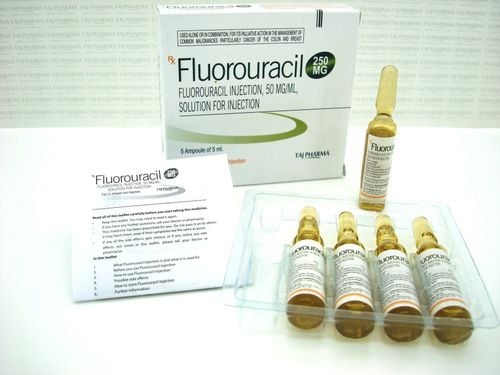This is an automatically translated article.
The article was professionally consulted by Dr. Trinh Thi Thanh Huyen - Obstetrician and Gynecologist - Department of Obstetrics and Gynecology - Vinmec Hai Phong International General HospitalOccasionally a nursing woman may notice that there is blood in her breast milk. This situation is noticed after you express milk or after the baby has spat out some breast milk during feeding. This is a concern of many mothers, especially those giving birth to their first child.
1. What factors affect the color of breast milk?
Human milk comes in different colors. If you have to use a breast pump, you can see a lot of variation in color. While formula always looks the same, the composition and condition of human milk changes constantly sometimes throughout the day and even during a single pumping or feeding.
Breast milk can be white, yellow, clear or sometimes even blue. Ingredients in many foods or beverages that a mother consumes during the day can be excreted in breast milk in a variety of ways. The following are common statements:
A diet rich in yellow and orange vegetables increases the carotene content of milk and causes the milk to turn yellow or orange. Mothers should rest assured because carotene is completely harmless to babies. Food colorings used in carbonated soft drinks, juices, and gelatin desserts can give milk a pink or orange-pink color. Green milk is considered relevant when the mother eats a lot of green vegetables, such as seaweed, broccoli... Frozen breast milk can look slightly yellow. Pink breast milk can be seen as having blood in it. Common sources are cracked nipples or blood in the milk that has been observed since the beginning. Brown milk can be caused from "rusty pipe syndrome". During pregnancy and in the first few days after giving birth, the ducts and milk-secreting cells in the breast need to grow and stretch, and blood flows to the breasts and sometimes leaks into the ducts. This gives your milk a brown or rusty color.

Tình trạng có máu trong sữa mẹ có thể do chế độ ăn uống
2. How to recognize signs of blood in breast milk?
According to the factors that determine the color of breast milk as above, it is quite common to have some blood in breast milk during the first few days of breastfeeding due to internal physiological changes. A small amount of blood usually goes unnoticed unless the mother is pumping or the baby spits up.
If a significant amount of blood in the milk has been swallowed, the baby may also have dark streaks of blood in her stool or the stool may even be tar-black, with a strong fishy odor.
If bleeding continues during the first few days of mixing with breast milk, the mother should be examined and examined, finding the cause to actively intervene with an obstetrician-gynecologist.
3. What are the causes of blood in breast milk?
Common causes of the presence of blood in breast milk include:
3.1. Rusty pipe syndrome
“Rust duct syndrome” is when the ducts and cells that make milk grow too quickly and stretch after birth. At this point, a small amount of blood is seen in breast milk for the first week or so.
This phenomenon poses no danger to the mother or the baby. Sometimes when a baby swallows blood, he may have a spit-up reflex that is stimulated by the blood, but it's not really harmful. “Rust tube syndrome” usually goes away 7 to 10 days after birth. During this time, it is best not to interrupt exclusive breastfeeding.
3.2. Cracked nipples
If the nipple is cracked or damaged during feeding, bleeding into the milk will be clearly observed.
The origin of blood and milk is completely different. Sometimes actively pumping with a tool can limit nipple damage, giving time to heal in the early days of not knowing the correct breastfeeding position.
3.3. Damage to the capillaries in the breast
Injury to the breast when expressing milk by hand or using a pump with too much suction can cause bleeding from the capillaries inside the breast parenchyma.
The milk-secreting glands of the breast tissue form very quickly during pregnancy. Therefore, the nourishing vascular system must also grow rapidly, so it has a fragile structure, which is easy to break when applying too much force.
3.4. Mastitis
Breast infection can cause bleeding from nipple

Viêm vú là một trong những nguyên nhân gây có máu trong sữa mẹ
3.5. Breast tissue pailloma
Papilloma is a benign growth on the lining of the milk ducts. If bleeding occurs, the condition causes the blood to appear pink.
These are usually not cancerous and are not painful, but can cause bleeding into the ducts when breastfeeding or pumping. However, breastfeeding still needs to continue and if not cause any irritation to the baby. On the other hand, if the baby has digestive problems from swallowing milk with blood in it, the mother may need to delay breastfeeding until the blood is gone, which usually takes 3-7 days.
3.6. Fibrosis of breast tissue
Breast fibrosis is a general condition for a group of symptoms in mammary gland tissue including breast pain, solid lumps and cysts.
This condition is by no means a contraindication to exclusive breastfeeding for the first 6 months of life unless the infant is still able to tolerate a good daily amount of breast milk.
3.7. Breast cancer
In most cases, blood in breast milk is probably not a cause for concern. However, some forms of malignancy, such as breast cancer, require early intervention to improve long-term outcomes.
4. Does the blood in breast milk cause any harm to the baby?
Blood in breast milk is still considered safe for exclusive breastfeeding during the first 6 months of life. Therefore, this should not be delayed or interrupted if the child shows no signs of intolerance.
However, if the mother has had any known blood-borne diseases, such as hepatitis, HIV, syphilis, breastfeeding should be consulted with the doctor. as soon as possible.
In addition, blood in breast milk can affect your baby in a number of ways as follows:
Change in your baby's taste in breast milk: Your baby may not like the taste of breast milk due to the presence of blood and becomes less prone to sucking or fussy when the breast. Blood in Baby's Stool: You can see your baby passing bloody stools. Children with bloating or vomiting: Children can still swallow, but the reaction of the stomach and blood in the milk is that the child is poorly tolerated.
5. What to do when there is blood in breast milk?
Treatment of cracked nipples: If blood is clearly from damaged nipples, it is best to stop breastfeeding and need to treat nipples until healed. Breastfeeding advice and guidance: One of the leading causes of nipple bleeding is not knowing the position of breastfeeding. Watch for signs of mastitis: If you have any flu-like symptoms, fever, redness in or around your breasts, tenderness, you may have mastitis and need immediate medical attention. Continue to breastfeed or pump: Since blood in breast milk is still considered safe for the baby, continue to breastfeed. If the mother does not know how to breastfeed in the correct position, the mother can use a breast pump. Because stopping breastfeeding suddenly can lead to many other serious problems like blocked milk ducts, mastitis, reduced milk production... Blood in breast milk will no longer be a problem. fear when mastering the information you need to know here. From there, each woman will become a knowledgeable breastfeeding mother, both protecting her own health, and ensuring the best nutrition and development for her baby in the first years of life. .
Please dial HOTLINE for more information or register for an appointment HERE. Download MyVinmec app to make appointments faster and to manage your bookings easily.
Articles refer to sources: hellomotherhood.com, healthline.com, verywellfamily.com












